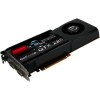- Qualcomm Launches Snapdragon 4 Gen 2 Mobile Platform
- AMD Launches Ryzen PRO 7000 Series Mobile & Desktop Platform
- Intel Launches Sleek Single-Slot Arc Pro A60 Workstation Graphics Card
- NVIDIA Announces Latest Ada Lovelace Additions: GeForce RTX 4060 Ti & RTX 4060
- Maxon Redshift With AMD Radeon GPU Rendering Support Now Available
EVGA GeForce GTX 285 SSC Edition

When NVIDIA released their GTX 285 card last month, it became the fastest single-GPU card on the market, and that fact still remains. But with our insatiable appetite for more performance, we can’t help but be curious as to how the cards perform when overclocked. So let’s check that out, with the help of EVGA’s SSC Edition.
Page 4 – Crysis Warhead
As PC enthusiasts, we tend to be drawn to games that offer spectacular graphics… titles that help reaffirm your belief that shelling out lots of cash for that high-end monitor and PC was well worth it. But it’s rare when a game comes along that is so visually-demanding, it’s unable to run fully maxed out on even the highest-end systems on the market. In the case of the original Crysis, it’s easy to see that’s what Crytek was going for.
Funny enough, even though Crysis was released close to a year ago, the game today still has difficulty running at 2560×1600 with full detail settings – and that’s even with overlooking the use of anti-aliasing! Luckily, Warhead is better optimized and will run smoother on almost any GPU, despite looking just as gorgeous as its predecessor, as you can see in the screenshot below.
The game includes four basic profiles to help you adjust the settings based on how good your system is. These include Entry, Mainstream, Gamer and Enthusiast – the latter of which is for the biggest of systems out there, unless you have a sweet graphics card and are only running 1680×1050. We run our tests at the Gamer setting as it’s very demanding on any current GPU and is a proper baseline of the level of detail that hardcore gamers would demand from the game.



At both our 1680×1050 and 1920×1200 resolutions, the SSC Edition card was able to deliver an excellent gameplay experience, but the hardcore resolution of 2560×1600 proved a bit too much. I admit though, even though we only received 28.177 FPS at that resolution, the game remained quite playable, but was faltered with occasional lag spikes.
|
Graphics Card
|
Best Playable
|
Avg. FPS
|
|
NVIDIA GTX 295 1792MB x 2
|
2560×1600 – Enthusiast, 0xAA
|
42.507 FPS
|
|
NVIDIA GTX 285 1GB x 2
|
2560×1600 – Gamer, 0xAA
|
45.835 FPS
|
|
Zotac GTX 295 1792MB
|
2560×1600 – Gamer, 0xAA
|
37.97 FPS
|
|
EVGA GTX 285 1GB SSC Edition
|
2560×1600 – Mainstream, 0xAA
|
54.551 FPS
|
|
Zotac GTX 285 1GB AMP!
|
2560×1600 – Mainstream, 0xAA
|
53.308 FPS
|
|
NVIDIA GTX 285 1GB
|
2560×1600 – Mainstream, 0xAA
|
51.283 FPS
|
|
Palit GTX 280 1GB
|
2560×1600 – Mainstream, 0xAA
|
46.912 FPS
|
|
XFX GTX 260/216 896MB
|
2560×1600 – Mainstream, 0xAA
|
40.750 FPS
|
|
Diamond HD 4870 1GB
|
2560×1600 – Mainstream, 0xAA
|
33.849 FPS
|
|
Palit HD 4870 X2 2GB
|
2560×1600 – Mainstream, 0xAA
|
30.670 FPS
|
|
Sapphire HD 4830 512MB
|
1920×1200 – Mainstream, 0xAA
|
37.051 FPS
|
|
Sapphire HD 4670 512MB
|
1920×1200 – Mainstream, 0xAA
|
25.175 FPS
|
Like the rest of our GTX 285 cards, our best playable setting was to retain our 2560×1600 resolution, but also lower our profile to Mainstream. It sucks to decrease anything with a $300+ GPU, but luckily, Crysis still looks quite amazing even with that detail setting, and in some cases, some people might even think it looks better (the “Gamer” profile makes everything darker, while “Mainstream” makes it much easier to see in the distance).
Support our efforts! With ad revenue at an all-time low for written websites, we're relying more than ever on reader support to help us continue putting so much effort into this type of content. You can support us by becoming a Patron, or by using our Amazon shopping affiliate links listed through our articles. Thanks for your support!






